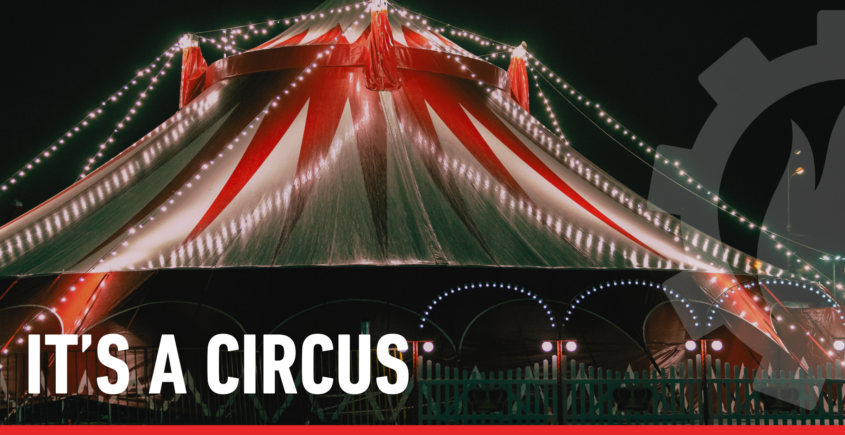It’s a Circus
With everything going on across the country, and all the changes in Washington, a friend of mine used the term “a circus” to describe all the events, attractions, daredevils, tightrope walkers, big animals, and more. It made me laugh, and also think of all of us managers out there “with a big hat and whip” trying to keep things going at our respective offices and plants. I remembered how the big top circus used to come to Cleveland every year and entertain us (I loved the tigers and elephants, the motorcycle guys in the round cage, and of course the trapeze artists. I went online and did some digging about the history of the circus here in America and found a wonderful bunch of facts and stories to share. Read on, and appreciate the size, scope, and talent of “The Greatest. Show On Earth” – (200 years ago was the introduction of the big top circus tent!). Enjoy, and thanks to Smithsonian magazine, Google, time.com, and Wikipedia for the info. Let the shows begin!

By popular demand, we’re now sharing guides for the previous week’s logo contest!
Every Friday, scroll to the bottom of the post to review last week’s guide and see if we managed to stump you.
The concept of circus-like entertainment dates back to ancient civilizations, where Romans held grand events featuring chariot races, acrobatics, and animal exhibitions. Popular throughout Europe, the circus eventually made its way to America in the early days of our country.
The first circuses in America were small. Although circus arts are ancient and transnational in origin, the modern circus was born in England during the 1770s when Philip Astley, a cavalryman, and veteran of the Seven Years War (1756-1763), brought circus elements—acrobatics, riding, and clowning—together in a ring at his riding school near Westminster Bridge in London. (I always wanted to be a clown). Yes, I realize that clowns are very scary for some…probably should be another blog for another time!
One of Astley’s students trained a young Scotsman named John Bill Ricketts, who brought the circus to America. In April of 1793, some 800 spectators crowded inside a walled, open-air, wooden ring in Philadelphia to watch the nation’s first circus performance.
The circus gained prominence in the 19th century. P.T. Barnum, a notable showman, entered the circus business at age 60, establishing “P. T. Barnum’s Grand Traveling Museum, Menagerie, Caravan & Hippodrome” in 1870. This traveling circus combined a menagerie with various performances, enhancing its appeal. When Barnum partnered with Bailey, they created the “Greatest Show on Earth”. When the circus rolled into American towns in the 1880s, daily life abruptly stopped. Months before the show arrived, an advanced team saturated the surrounding region with brilliantly colored lithographs of the extraordinary: elephants, bearded ladies, clowns, tigers, acrobats, and trick riders.
On “Circus Day,” huge crowds gathered to observe the predawn arrival of “herds and droves” of camels, zebras, and other exotic animals. Families witnessed the raising of a tented city across nine acres and a morning parade that made its way down Main Street, advertising the circus as a wondrous array of captivating performers and beasts from around the world. (I can still remember the elephant along the track and walk through downtown in Cleveland).
Three-ring circuses like Barnum and Bailey’s were a product of the same Gilded Age historical forces that transformed a fledgling new republic into a modern industrial society and rising world power. The extraordinary success of the giant three-ring circus gave rise to other forms of exportable American giantism, such as amusement parks, department stores, and shopping malls.
P.T. Barnum, already a veteran amusement proprietor, recognized the opportunity when he saw it. He had set a bar for giantism when he entered the circus business in 1871, staging a 100-wagon “Grand Traveling Museum, Menagerie, Caravan, and Circus.” The very next year, Barnum’s sprawling circus took to the rails. His partner William Cameron Coup designed a new flatcar and wagon system that allowed laborers to roll fully loaded wagons on and off the train.
Barnum and Coup were outrageously successful, and their innovations pushed the American circus firmly into the combative scrum of Gilded Age capitalism. Before long, size and novelty determined a show’s salability. Rival showmen quickly copied Barnum’s methods. Competition was fierce. Advance teams posting lithographs for competing shows occasionally erupted in brawls when their paths crossed.
In 1879, James A. Bailey, whose circus was fresh off a two-year tour of Australia, New Zealand, and South America, scooped Barnum when one of his elephants became the first to give birth in captivity at his show’s winter quarters in Philadelphia. Barnum was begrudgingly impressed—and the rivals merged their operations at the end of 1880. Like other big businesses during the Gilded Age, the largest railroad shows were always prowling to purchase other circuses.
Railroad showmen embraced popular Horatio Alger “rags-to-riches” mythologies of American upward mobility. They used their spectacular ascent to advertise the moral character of their shows. Bailey had been orphaned at eight and had run away with a circus in 1860 at the age of 13 to escape his abusive older sister. The five Ringling brothers, whose circus skyrocketed from a puny winter concert hall show in the early 1880s to the world’s largest railroad circus in 1907, were born poor to an itinerant harness maker and spent their childhood eking out a living throughout the Upper Midwest.
These self-made American impresarios built an American cultural institution that became the nation’s most popular family amusement. Barnum and Bailey’s big top grew to accommodate three rings, two stages, an outer hippodrome track for chariot races, and an audience of 10,000. Afternoon and evening performances showcased new technologies such as electricity, safety bicycles, automobiles, and film; they included reenactments of current events, such as the building of the Panama Canal.
By the end of the century, circuses had entertained and educated millions of consumers about the wider world and employed over a thousand people. Their moment had come. In late 1897, Bailey took his giant Americanized circus to Europe for a five-year tour, just as the U.S. was coming into its own as a mature industrial powerhouse and mass cultural exporter.
Bailey transported the entire three-ring behemoth to England by ship. The parade alone dazzled European audiences so thoroughly that many went home afterward mistakenly thinking they had seen the entire show. In Germany, the Kaiser’s army followed the circus to learn its efficient methods for moving thousands of people, animals, and supplies
Bailey’s European tour was a spectacular success, but his triumph was fleeting. He returned to the United States in 1902 only to discover that the upstart Ringling Brothers now controlled the American circus market.
When Bailey died unexpectedly in 1906, and the Panic of 1907 sent financial markets crashing shortly thereafter, the Ringlings were able to buy his entire circus for less than $500,000. They ran the two circuses separately until federal restrictions during World War I limited the number of railroad engines they could use. Thinking the war would continue for many years, the Ringlings decided to consolidate the circuses temporarily for the 1919 season to meet federal wartime regulations. They merged their shows, creating the “Ringling Bros. and Barnum & Bailey Circus,” famously dubbed “The Greatest Show on Earth.”
Over the years that followed, animal performances, once a staple, faced increasing scrutiny over ethical concerns. This led to significant changes, including the phasing out of elephant acts and, eventually, the removal of all animal performances in some modern circuses.
On May 21, 2024, the most famous circus of all, Ringling Bros. and Barnum & Bailey ended its 146-year run, not with a whimper or a bang but mostly a shrug. Death has been a long time coming. A company press release put much of the blame on the pressure from animal-rights groups, to stop using elephants as performers. But in fact, the Greatest Show on Earth was slowly headed for this day since the 1950s, when the same force that killed vaudeville—television—drove the storied operation out of its vast canvas big tops and into ho-hum auditoriums and arenas.
With approximately 500 performances a year – that’s around 50,000 performances over the lifetime of the RB B&B circus. – quite a feat indeed!
How did you do on last week’s logo contest?
Check out our logo guide for the “Happy Spring!” post here!






Leave a Reply
Want to join the discussion?Feel free to contribute!